ISSN ONLINE(2319-8753)PRINT(2347-6710)
ISSN ONLINE(2319-8753)PRINT(2347-6710)
Nihal M.A. El-Sayar*1, Islam Helaly Abdel-Aziz Afefy2, A. M. El-kamash3
|
| Related article at Pubmed, Scholar Google |
Visit for more related articles at International Journal of Innovative Research in Science, Engineering and Technology
Systems Engineering is an interdisciplinary and holistic discipline with methods and techniques to address complex problems. This paper proposes an integration of system life-cycle processes and stages from ISO/IEC 15288 with the proposed tools-model framework as a basic framework, allowing team to generate data, define customer needs, optimize solutions, architecture the system, make decisions, validate, analyze failures, and realize the system. This paper gives a short presentation of tools-model framework application on a real case in industry. The application of this proposed model led to a significant increase of the firm total and (labors, materials) partial productivity, qualityproductivity index, profit, and value added almost by (39%, 65%, 20%, 39%, 202%, and 119%) respectively, noticeable positive decrease of defective products percentage, downtime, rework, and lead time almost by (79%, 28%, 98%, and 80%) respectively, also acquiring new customers and new products, besides developing training programs, and solving customer claims
Keywords |
| Systems Engineering (SE), ISO/IEC 15288, systems engineering tools, Systems life-cycle integration, Systems Engineering Lifecycle-Tools-Model Framework (SELTMF) |
INTRODUCTION |
| Systems Engineering (SE) is an interdisciplinary, collaborative approach to enable the realization of successful systems verifying a life-cycle balanced system solution which satisfies customer needs. SE treats the whole system and even its elements treating any thing as a system. The SE management is accomplished by the three activities; development phasing, SE process, and life-cycle integration. Terry and Frank [1] defined SE and determined seven tasks of SE: (State the problem, Investigate alternatives, Model the system, Integrate components, Launch the system, Assess performance, and Re-evaluation) explaining the seven phases of life-cycle in details and defined the purpose of SE as is to produce systems satisfy customers' needs, increase success probability, and reduce risk and total-life-cycle cost. Frank [2] explained that the need for SE is dependent on the size of the system under consideration, its complexity, its technological risk, and the needs of the customer in defense and in commercial practice. Clement and Susan [3] showed that SE encompasses the entire product life-cycle, including product conceptualization. They summarized the present state and future direction of SE research that one can leverage to most effectively support bid efforts. Russell [4] proposed a methodology to support non specialist end users in the identification, organization and discussion of information required to manage SoS evolution, and uses a modified form of Hazard and Operability Study (HAZOPS) to analyze the associated risks of evolution. Bogle et. al [5] applied the process SE techniques to biochemical processes taking into account an important role in batch biochemical processes for Computer Assisted Operation (CAO), i.e. planning of operations on a day-to-day bases using simulation tools. SE is the art and science of developing an operable system capable of meeting requirements within often opposed constraints. The analysis confirmed that the objectives of software engineering, the problems encountered managing it, and the techniques used to resolve those problems are essentially the same as those found in SE. So, Mark [6] showed the activities that are common to SE and software engineering. David [7] showed recurrence plots reveal long-term and emergent behavior in complex systems when specific criteria are met. This technique may be used in SE in such diverse areas as systems architecture to predict emergent behaviors in complex systems and program management to predict the long-term health of a complex project among others. In energy systems applications, Jamal et. al [8] Studied how SE methods can help address today's grand challenges, such as energy problem through defining problem by articulating the problem in its context as clearly as possible, Sharpening the problem further by transforming it into need statements and using SE modeling and analysis techniques to understand, communicate, debate, and facilitate decisions about complex problems and assessing potential solutions. Albert and John [9] described a novel approach through development of V-model for integrating manufacturing and supply chain considerations into the SE process applied for aerospace and defense industry through the cost of developing new generation of system continues to spiral out of control. Marianne and Gerrit [10] investigated the value of specific SE tools applied to the flow and storage of finished products included: context diagram, physical architecture, Integration Definition for Function Modeling (IDEF0) diagrams, Use Case Scenarios, Scenario Tracing and Geographical Model. As risk analysis and affordability, Quentin [11] used affordability as a decision making tool, which can be approved, measured and predicted. he provided analytical path from determining requirements to fielding affordable systems conducting research into the concepts of affordability and methods to implement the approach. He also established a foundation for creating affordability SE Sciences, he initiated research of complexity sciences to understand links between fitness and affordability, and also investigated game theoretical modeling and other advanced SE concepts to focus on thrusts. Hee et. al [12] used the SE approach to guide the development of a new business model-based design method using these tools though the project phases such as IDEF0 model, functional architecture, Strength, Weakness, Opportunity, Threats (SWOT) analysis, buyer utility map, fault analysis tree, pre-defined assessment system, Quality Function Deployment (QFD), and system analysis and control including trade-off studies, effectiveness analyses, risk management, configuration management, interface management, data management, and so on. By using SE, project success rates were enhanced from 16% to 28% in 2000. The design process for damage control support systems was based on SE process of ISO/IEC 15288, EIA/ANSI 632, and IEEE 1220. The International Standard, Systems Engineering Life Cycle Processes, (ISO/IEC 15288) [13] established a common framework for describing the life cycle of systems and defined a set of processes and stages. These processes can be applied at any level in the hierarchy of a system’s structure to the whole life-cycle including conception, development, production, utilization, support and retirement of systems using tasks of defining customer needs, stating the system problems, investigating solutions, modeling the system of interest, managing functions interfaces, and assessment of the system to get a product or introduce a service. The life-cycle processes can be applied concurrently and iteratively to a system and its elements on any system. It therefore applies to one-of-a-kind, massproduced, customized and adaptable systems or services systems. Department of Defence (DoD), NATO, Ministry of Defence (MoD), and National Aeronautics and Space Administration (NASA) all developed SE model frameworks and NATO has decided that ISO/IEC 15288 shall be the framework for Systems Life-Cycle Management (SLCM) [14]. NASA [15] has provided its own SE framework to be a general guidance and information on SE that will be useful to the NASA community. Tommy et. al [14] presented an example on how ISO/IEC 15288, Architectural Frameworks and Modeling and Simulation (M&S) can be integrated and the benefits of that integration, especially how M&S can be used to develop and execute system designs giving a presentation of some ideas concerning tool support such as MODAF with six viewpoints. The existing frameworks depended on one or more SE tools, however system life-cycle processes, stages can be integrated using a complete SE tools-model framework. So, the present paper introduces to ISO/IEC 15288 life-cycle processes and stages, aiming to present the proposed model framework of system life-cycle integration using support tools as the basic building blocks in this model. It presents how the life-cycle processes, stages, and tools can be integrated and the benefits of that integration, especially how SE tools can be used to present, model, develop and execute the system. It also assess this proposed model by applying it to a real industrial case to improve its system performance. |
SYSTEMS ENGINEERING LIFE-CYCLE |
| The System Life-cycle Processes The SE life-cycle processes are described in four process groups according to ISO/IEC 15288; Agreement Processes, Enterprise Processes, Project Processes, and Technical Processes [13]. These groups and their included processes are illustrated by Figure 1 Each group will be described very briefly in the following sections. |
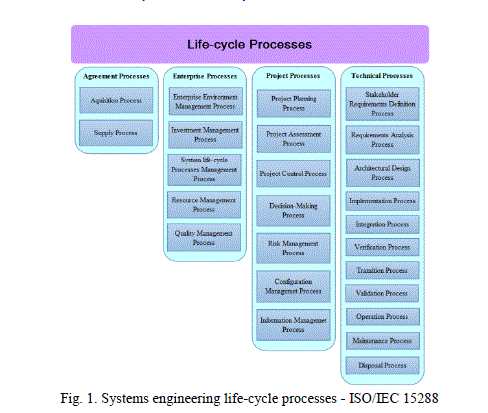 |
ISO/IEC 15288 LIFE-CYCLE PROCESSES, PHASES, AND SE TOOLS INTEGRATION |
| Life cycle integration is necessary to ensure that the design solution is viable throughout the life of the system. It includes the planning associated with product and process development, as well as the integration of multiple functional concerns into the design and engineering process. In this manner, product cycle-times can be reduced, and the need for redesign and rework substantially reduced. Life cycle integration is achieved through integrated development—that is, concurrent consideration of all life cycle needs during the development process. Any system is a construct or collection of different elements that together produce results not obtainable by the elements alone. The elements, or parts, can include people, hardware, software, facilities, policies, and documents; that is, all things required to produce system-level results. The results include system-level qualities, properties, characteristics, functions, behavior, and performance, and so as to the SE methods and techniques. The most of the system life-cycle processes presented former are used to some extent during every stage of a system life-cycle that is executed by applying SE tools. Figure 3 roughly illustrates to what extent the process groups and tools are used in the different stages. |
 |
THE SYSTEMS ENGINEERING TOOLS |
| SE tools, will allow the team to generate and manage information, understand customer requirements, explore design options, optimize solutions, make decisions, validate, implement and realize the system, these tools could be mathematical, graphical, modeling, and architecture [16, 17, 18]. SE Tools demonstrate how using integrated or concurrent engineering methods, copiously illustrated with figures, charts, and graphs offering methods, frameworks, and techniques for designing, implementing, and managing systems exhibiting the effect of the SE concept and its importance during the design and development of a complex system. A. The Systems Engineering Tools Framework The efforts within the area of frameworks that we know of; the Incremental Commitment Spiral Model, Model Oriented Systems Engineering, Model Driven Architectures, Model-Based Systems Engineering, Department of Defense Architectural Framework, and Ministry of Defense Architectural Framework (ICSM, MOSES, MDA, MBSE, DoDAF, and MoDAF) all strives to create a common architecture framework for descriptions of system architectures [19, 20, 21, 22, 14, 23]. According to interpretations, the main goal with any model framework, is to support development and documentation, of the system, defining stakeholders and communicating between them. Systems frameworks may use one or more tool to demonstrate the system of interest. ―Systems Engineering Tools Framework - SETF‖ map presents the tools application through the whole life-cycle of any system, the proposed tools for each level, and the application cycle over the life-cycle, that is illustrated by Figure 5. The tools are categorized into four main groups illustrating its utility and usage through the proposed SE model, these categories and tools utilization into the SE model are as follow: |
| Architecture framework; is considered a general step in the tools-model framework and is the core of this framework. It is a way to viewing and defining an enterprise, providing a comprehensive approach for designing, planning, implementing, and governing an architecture. |
| Defining requirements; gathering, defining, and analyzing data of customer or system requirements, where tools such as Affinity Diagram, Need Means Analysis, Viewpoint Analysis can be used during the system concept stage to state the system issues. Creating and optimizing solutions; investigating, exploring, and assessing existing development system and proposed solution alternatives using Function Means Analysis for example, and FFMEA to determine and prioritize failure modes. System viewing and modeling; to determine system reliability, presenting, and assessing system development and utilization it is needed to view this system using modeling tools such as V-model or IDEF. System verification and analysis; system supportability, testing, assessment, or failure analysis can be done using Quality Function Deployment or Fault tree Analysis and then get system feedback to reevaluate its solution concepts. |
| The Systems Engineering Tools Framework Application Examples There are an increasing number of opportunities for systems engineers to make important contributions for manufacturing and services fields. The filed of application is a company, which is considered a subcontractor (tier) serving many companies in Egypt working in many fields such as vehicles (the biggest customer), plastics, electrical equipments, etc. This industry undergo some main stages in the manufacturing process as design, receiving raw materials, sheet metal cutting and pressing, plastic injection, assembly, treatment and painting, and finally delivering to customer. The SE is applied to this company considering it all as a system using SETF categories to present this system treating its issues. 1) System architecture framework: It is required to view the enterprise, design, plan, implement, and govern the enterprise architecture. In British Ministry of Defence Architecture Framework (MODAF), the problem space is split into manageable pieces, defined as views, which enables decision-makers to manage complexity. Each view has a particular purpose and the views are categorized under seven viewpoints, shown in Figure 6. Some of the views provide high level information about the system; whilst others describe specific aspects or relationships between different aspects of the system. |
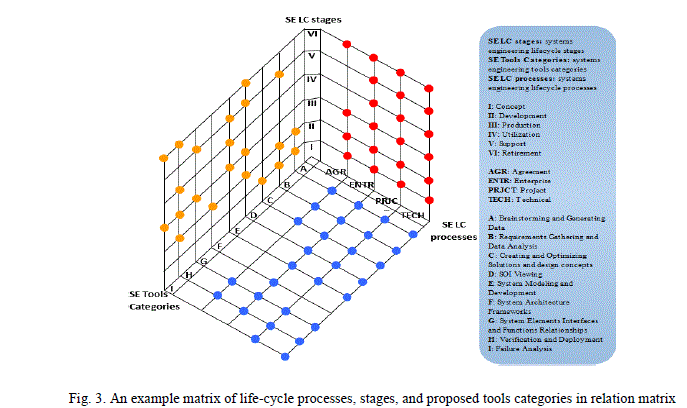 |
| 2) Defining Requirements: To describe these tools clearly, they are applied to a real system that is an industrial firm is considered as a second tier to vehicles assembly firms and this is one of the company’s varied activities. This plant is needed to fulfill customer requirements, so it has its entire requirements and validation system to ensure its ability to compete and test solutions of improvement. Teamwork is configured to discover the considered requirements, Viewpoint Analysis (VPA) is a tool of requirements gathering and data analysis tools, which has been applied to identify requirements, as illustrated by Figure 7. The main boxes present the functional requirements, while the surrounded ones are non-functional requirements (constraints). |
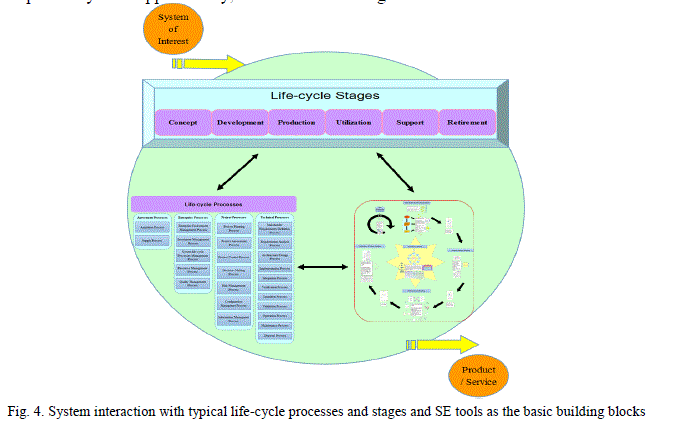 |
| 4) SOI Modeling: To present the system and state the issues for any system of interest, firstly the actual system process life-cycle has to be understood and then identifying points of weakness through this life-cycle by modeling the system life-cycle using V-model as a system development tool as illustrated by Figure 9. This model presents the firm processes life-cycle starting at defining customer needs until delivering orders, it is obviously noticed that the main points of lack lie on: Receiving of raw and consumable materials, Products quality, Order delivery time (delay time), and Management (organizing orders and communications between administrations). |
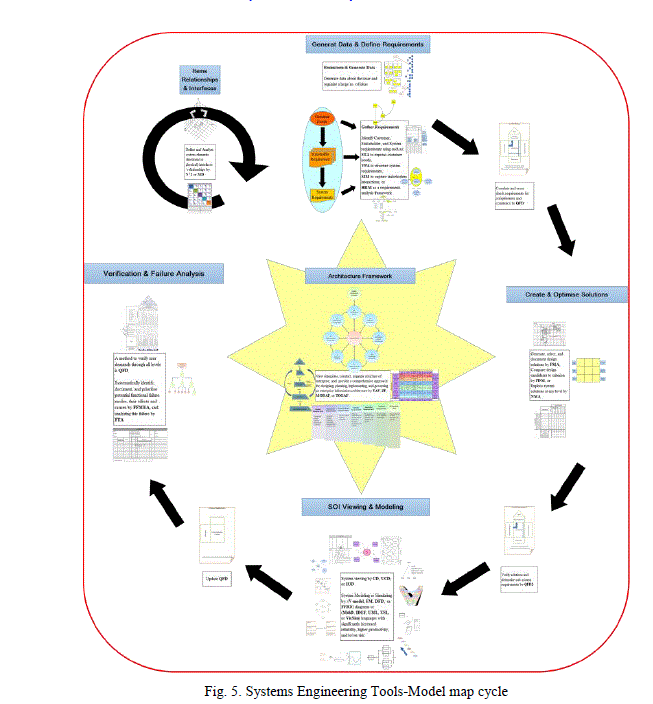 |
| 5) System Verification and Failure Analysis: It is required for any system to verify and assess its performance, cost, and risk to ensure it is on track for fulfilling customer needs, also to verify and continuously assess system performance that is useful for feedback and re-evaluating the system. Quality Function Deployment (QFD) is a tool for detecting system development and relationships among main functions, as illustrated by Figure 10. The QFD, - as known - its left side presents the voice of the customer, the roof presents the voice of the company itself, and the lower part presents how the company shall fulfill customer requirements. The parts of comparing the current company to other customer’s tiers and to measure the company gap to targets its weight is calculated by; [ Ʃ (Priority x Relationship)], where the priority is the customer importance and the relationships presents the value assessment matrix between the voice of the customer and the voice of the company. 6) System Integration: Integration means designing interfaces and bringing system elements together so they work as a whole. This requires extensive communication and coordination. Interfaces between different subsystems, the main system and the customers must be designed. Subsystems should be defined to minimize the amount of information to be exchanged between the subsystems. Figure 11 illustrates the use of an interfaces tools that is N2 chart. This N2 diagram represents and analyses the functional or physical interfaces between system elements. As shown by Figure 10, the central main blocks presents functions (system elements) numbered by F(n) according to the function number, the upper side of this matrix presents the forward relationship from function to another, and the lower side of the matrix presents the backword relationship. Proposed SELTMF Model Application Validation |
| During the operating of the SELTMF on the system life cycle the performance of the system should be developed. Initially the following measurements will be done to validate that the system is in compliance with its requirements. The system is assessed by using some performance measures, some enterprise Key Performance Indicators - KPIs for the whole investment [24], are used to assess the system an compare the situation before applying the SELTMF and during applying it. These measures are applied to the application firm during two periods one before applying the SELTMF and the other one is during the application of this proposed model as an assessment method. Each period is three months means a quarter of the year (Qrt). The suggested KPIs are illustrated by; Table 1 that represents the needed measures for these KPIs, and detailed analysis of these KPIs and how to be calculated are illustrated by Table 2. |
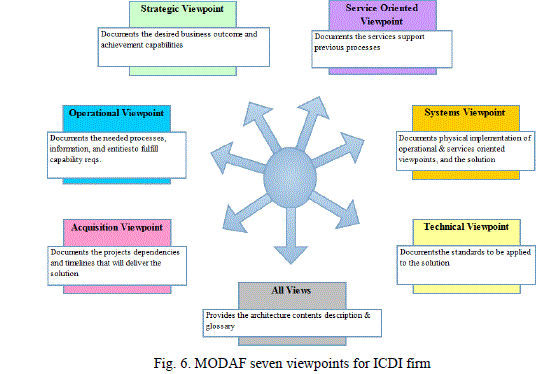 |
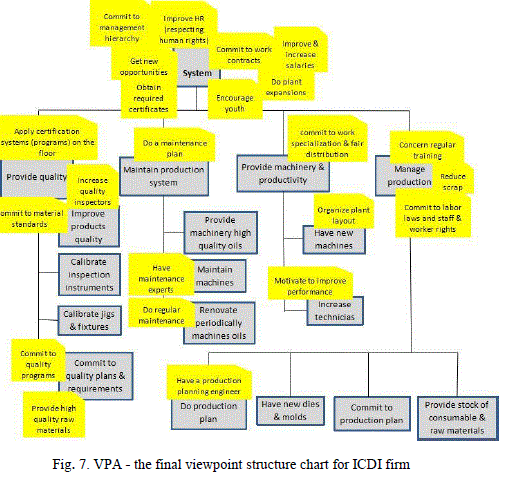 |
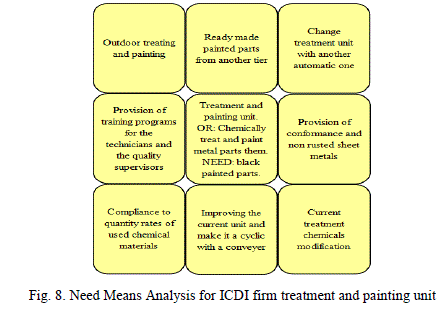 |
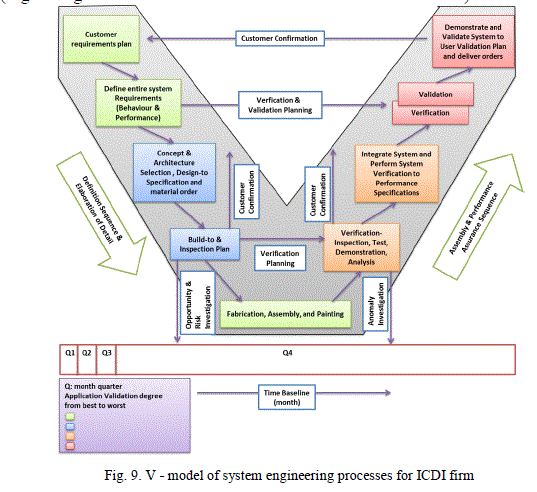 |
| The analysis of the company performance ensures that due to SE application the company started to improve its performance as illustrated by measures. This is noticed through: a significant increase of the firm total and (labors, materials) partial productivity, quality-productivity index, profit, and value added almost by (28%, 39%, 17%, 28%, 67%, and 54%) respectively, noticeable positive decrease of defective products percentage, rework, and lead time almost by (+100%, +100%, and +100%) respectively, also acquiring new customers and new products, besides developing training programs, and solving customer claims. |
CONCLUSION |
| While there are challenges implementing any approach, it is possible to get some helpful information and recommended reforms. Many organizations divide their Systems into three main categories according to their major workflows that is recommended to be done into this company of application: Requirements definition, Architectural design and Testing and verification. This firm as like many companies its priorities are based on cost and revenue, that is not a flaw but it does not realize that in order to get high marks for low cost it should be interested in three major pillars: Human factor, Administration hierarchy organizing, and Quality issues. This enterprise system should set up a configuration (modification) management and project management All of these SE activities must be documented in a common repository, it could be hardware or software. |
References |
|